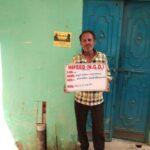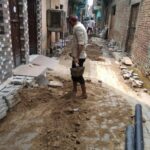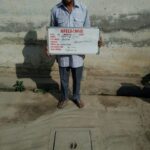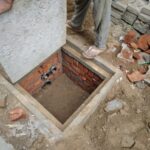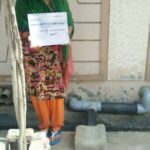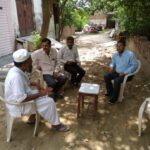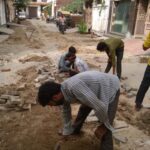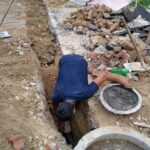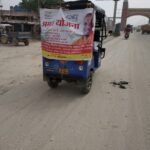CARRYOUT IEC ACTIVITIES IN ULBS OF UTTAR PRADESH
CARRYOUT INFORMATION EDUCATION & COMMUNICATION (IEC) ACTIVITIES AND TO MOTIVATE HOUSEHOLDS TO CONNECT WITH SEWER NETWORK OF MUZAFFAR NAGAR, MEERUT, GHAZIABAD AND LONI URBAN LOCAL BODIES (ULBS) OF UTTAR PRADESH
INTRODUCTION AND BACKGROUND OF THE PROJECT
The Namami Gange Program, a significant government initiative, bears the responsibility of devising strategies, allocating resources, overseeing progress, and coordinating multifaceted efforts directed towards the substantial reduction of pollution and the preservation of the Ganga River. On a state level, the Uttar Pradesh State Ganga River Conservation Agency (UPSGRCA) stands as a pivotal establishment, functioning as a State Project Management Group (SPMG) within the purview of the Department of Urban Development under the governance of the Uttar Pradesh Government. The core objective of this agency is to orchestrate and execute a spectrum of activities associated with the Namami Gange Program at the state level, extending its influence to encompass endeavours supported by World Bank-assisted projects.
Within the framework of the overarching goals set forth by the Namami Gange Program, the State Program Management Group has meticulously devised a strategic blueprint designed to fortify the administration of sewer networks spanning multiple urban centers within the state. With surgical precision, this initiative is poised to address a specific challenge, the presence of households that remain unconnected to the existing sewer network, alongside those whose wastewater discharge is exclusively confined to septic tanks. A cornerstone of this concerted endeavour hinges upon the comprehensive and meticulous collection of wastewater originating from all conceivable sources, be it bathrooms, toilets, or kitchens, and its subsequent efficacious integration into the established sewer infrastructure. The gravity of this undertaking necessitates a sweeping and pervasive campaign, diligently driven by social intermediation and all-encompassing outreach initiatives. The campaign, in its essence, endeavours to catalyze a transformative shift in societal conduct, engender a heightened sense of awareness, and kindle a motivational impetus within individuals to ardently seek out household connections to the prevailing sewer network, particularly within the demarcated districts.
AIMS AND OBJECTIVES OF THE PROJECT
1. Initiate comprehensive Information, Education, and Communication (IEC) campaigns to effectively inspire households within their respective districts to seamlessly integrate with the sewer network.
2. Facilitate direct engagement with households and local communities, acting as dedicated advocates representing the executing agencies and urban local bodies.
3. Employ educational endeavours to raise community awareness regarding the manifold advantages of adopting household connections, simultaneously fostering an environment of enthusiastic community involvement.
4. Ensure the seamless and sustainable execution of the project, driven by a resolute commitment to achieving universal household connections, thereby enhancing the project’s lasting impact and continued viability.
5. Align the project’s primary objective with the broader mission of preventing the discharge of untreated wastewater into the River Ganga, thereby contributing significantly to environmental preservation.
COMPONENTS AND ACTIVITIES OF THE PROJECT
1. Establish a pivotal role as an intermediary between Executing Agencies, the State Project Monitoring Group (SPMG), and pertinent entities such as Jal Nigam, Urban Local Bodies (ULBs), and local households, with a focused objective of achieving the full realization of a 100% sewerage system coverage within designated districts.
2. Acquire and collate essential sewer line information sourced from SPMG/Executing Agency and U.P. Jal Nigam, specifically pertaining to delineated urban areas.
3. Undertake comprehensive on-site visits aimed at identifying and cataloguing households, including their addresses and contact numbers. This vital data is subsequently communicated to both SPMG and Project Managers of Executing Agencies/Urban Local Bodies. The organization assumes a proactive role in enlightening households, stimulating demand, and delivering ongoing support for seamless integration into the sewer network, while fostering motivation throughout the construction phase.
4. Facilitate the seamless exchange of certified household particulars (including area, addresses, owner names, and contact numbers) as authenticated by Urban Local Bodies/Executing Agencies, specifically for the stipulated District. This information is seamlessly integrated into the dedicated website/Management Information System (MIS) established by SPMG.
5. Strategically implement Information, Education, and Communication (IEC)/Behaviour Change Communication (BCC) initiatives, meticulously designed to inculcate behavioural shifts and ensure the sustained utilization of sewer services.
6. Regularly furnish a comprehensive monthly report to both SPMG and Urban Local Bodies, encompassing a detailed roster of successfully completed household connections. Additionally, the organization is entrusted with the responsibility of meticulously uploading connection particulars, complete with accompanying photographs, onto the dedicated MIS developed by UPSPMG upon the successful fulfilment of tasks.
TARGET AREA OF THE PROJECT
The project is focused on a designated target area comprising four Urban Local Bodies (ULBs) in Uttar Pradesh, namely Muzaffarnagar, Meerut, Ghaziabad, and Loni, allocated to the organization.
TARGET GROUPS AND BENEFICIARIES OF THE PROJECT
The project’s beneficiaries included the entire community residing within the designated Urban Local Bodies (ULBs), where the project conducted Information, Education, and Communication (IEC) campaigns to encourage households to smoothly integrate with the sewer network.
FUNDING PARTNER OF THE PROJECT
The Uttar Pradesh State Ganga River Conservation Agency (UPSGRCA), Department of Urban Development, Government of Uttar Pradesh, Lucknow was the funding partner for the project.
SANCTIONED BUDGET OF THE PROJECT
The UPSGRCA approved the project in 2018 via sanction order No. 5520/9-5-17-449 Sa/2017, dated 09.01.2018, allocating a total budget of Rs. 12,48,400.00 for one year.
OUTCOMES AND ACHIEVEMENTS OF THE PROJECT
The successful implementation of the assigned project is evident through a range of accomplishments and outcomes, as indicated below:
1. Initiatives have been launched to comprehensively initiate Information, Education, and Communication (IEC) campaigns aiming to inspire households within their respective districts for seamless sewer network integration, coupled with the strategic implementation of Information, Education, and Communication (IEC)/Behaviour Change Communication (BCC) initiatives to foster sustained sewer service utilization.
2. Proficiently facilitating direct engagement with households and local communities has taken place, serving as dedicated advocates for executing agencies and urban local bodies.
3. Diligent educational initiatives have effectively heightened community awareness about the manifold benefits of adopting household connections, fostering active and engaged community participation.
4. The project’s execution has been characterized by its seamless and sustainable approach, underpinned by an unwavering commitment to achieving universal household connections and augmenting long-term impact.
5. A pivotal intermediary role has been established, connecting Executing Agencies, SPMG, Jal Nigam, ULBs, and households, with a steadfast emphasis on attaining comprehensive 100% sewerage system coverage.
6. Successful sourcing of essential sewer line information from entities like SPMG/Executing Agency and U.P. Jal Nigam has resulted in its proficient acquisition and collation.
7. Thorough and comprehensive on-site visits have meticulously identified and documented households, with meticulously shared data effectively conveyed to both SPMG and Project Managers, ensuring continuous and unwavering support.
8. Certified household particulars have been exchanged, seamlessly integrating them into the website/Management Information System (MIS) developed by SPMG.
9. Regular submission of comprehensive monthly reports to SPMG and Urban Local Bodies has occurred, encompassing completed household connections and uploaded particulars on the dedicated MIS.
10. The primary project objective, aligned with the mission of preventing untreated wastewater discharge into the River Ganga and its tributaries, contributing significantly to environmental preservation, has been successfully achieved.



